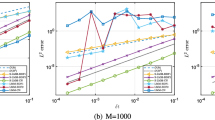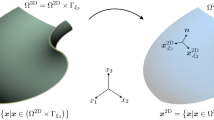Summary.
A new a posteriori residual error estimator is defined and rigorously analysed for anisotropic tetrahedral finite element meshes. All considerations carry over to anisotropic triangular meshes with minor changes only. The lower error bound is obtained by means of bubble functions and the corresponding anisotropic inverse inequalities. In order to prove the upper error bound, it is vital that an anisotropic mesh corresponds to the anisotropic function under consideration. To measure this correspondence, a so-called matching function is defined, and its discussion shows it to be a useful tool. With its help anisotropic interpolation estimates and subsequently the upper error bound are proven. Additionally it is pointed out how to treat Robin boundary conditions in a posteriori error analysis on isotropic and anisotropic meshes. A numerical example supports the anisotropic error analysis.
Similar content being viewed by others
Author information
Authors and Affiliations
Additional information
Received April 6, 1999 / Revised version received July 2, 1999 / Published online June 8, 2000
Rights and permissions
About this article
Cite this article
Kunert, G. An a posteriori residual error estimator for the finite element method on anisotropic tetrahedral meshes. Numer. Math. 86, 471–490 (2000). https://doi.org/10.1007/s002110000170
Issue Date:
DOI: https://doi.org/10.1007/s002110000170




